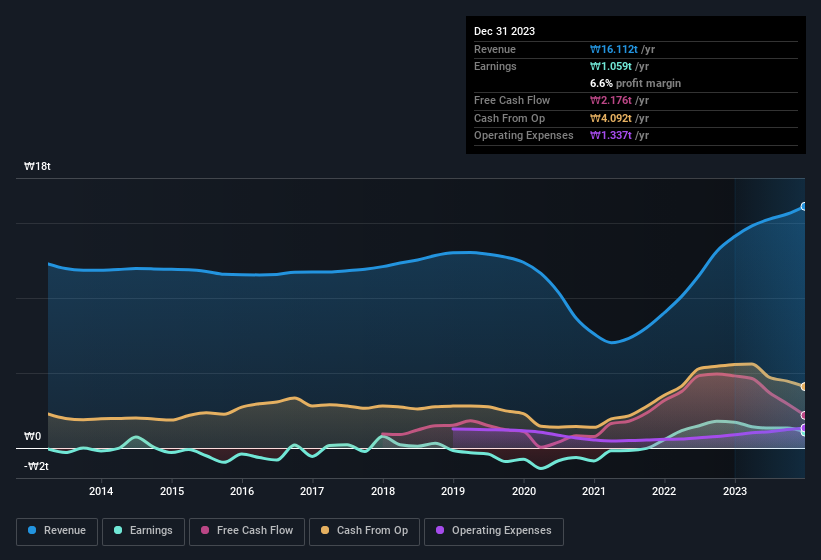- South Korea
- /
- Airlines
- /
- KOSE:A003490
We Think You Can Look Beyond Korean Air Lines' (KRX:003490) Lackluster Earnings

The market for Korean Air Lines Co., Ltd.'s (KRX:003490) shares didn't move much after it posted weak earnings recently. Our analysis suggests that while the profits are soft, the foundations of the business are strong.
View our latest analysis for Korean Air Lines

Examining Cashflow Against Korean Air Lines' Earnings
In high finance, the key ratio used to measure how well a company converts reported profits into free cash flow (FCF) is the accrual ratio (from cashflow). The accrual ratio subtracts the FCF from the profit for a given period, and divides the result by the average operating assets of the company over that time. The ratio shows us how much a company's profit exceeds its FCF.
As a result, a negative accrual ratio is a positive for the company, and a positive accrual ratio is a negative. That is not intended to imply we should worry about a positive accrual ratio, but it's worth noting where the accrual ratio is rather high. That's because some academic studies have suggested that high accruals ratios tend to lead to lower profit or less profit growth.
Korean Air Lines has an accrual ratio of -0.11 for the year to December 2023. That indicates that its free cash flow was a fair bit more than its statutory profit. To wit, it produced free cash flow of ₩2.2t during the period, dwarfing its reported profit of ₩1.06t. Korean Air Lines' free cash flow actually declined over the last year, which is disappointing, like non-biodegradable balloons.
That might leave you wondering what analysts are forecasting in terms of future profitability. Luckily, you can click here to see an interactive graph depicting future profitability, based on their estimates.
Our Take On Korean Air Lines' Profit Performance
Korean Air Lines' accrual ratio is solid, and indicates strong free cash flow, as we discussed, above. Because of this, we think Korean Air Lines' earnings potential is at least as good as it seems, and maybe even better! Unfortunately, though, its earnings per share actually fell back over the last year. Of course, we've only just scratched the surface when it comes to analysing its earnings; one could also consider margins, forecast growth, and return on investment, among other factors. So while earnings quality is important, it's equally important to consider the risks facing Korean Air Lines at this point in time. While conducting our analysis, we found that Korean Air Lines has 2 warning signs and it would be unwise to ignore these bad boys.
This note has only looked at a single factor that sheds light on the nature of Korean Air Lines' profit. But there are plenty of other ways to inform your opinion of a company. For example, many people consider a high return on equity as an indication of favorable business economics, while others like to 'follow the money' and search out stocks that insiders are buying. So you may wish to see this free collection of companies boasting high return on equity, or this list of stocks that insiders are buying.
Valuation is complex, but we're here to simplify it.
Discover if Korean AirlinesLtd might be undervalued or overvalued with our detailed analysis, featuring fair value estimates, potential risks, dividends, insider trades, and its financial condition.
Access Free AnalysisHave feedback on this article? Concerned about the content? Get in touch with us directly. Alternatively, email editorial-team (at) simplywallst.com.
This article by Simply Wall St is general in nature. We provide commentary based on historical data and analyst forecasts only using an unbiased methodology and our articles are not intended to be financial advice. It does not constitute a recommendation to buy or sell any stock, and does not take account of your objectives, or your financial situation. We aim to bring you long-term focused analysis driven by fundamental data. Note that our analysis may not factor in the latest price-sensitive company announcements or qualitative material. Simply Wall St has no position in any stocks mentioned.
About KOSE:A003490
Undervalued with adequate balance sheet.


